Ecological Impacts
of proposed Dunoon Dam
Written by ecologist, Nan Nicholson.
I am a rainforest botanist and farmer and have lived in the Northern Rivers since 1974. I am the author of Australian Rainforest Plants I-VI, for which my husband Hugh is the photographer. I am a co-author of the interactive identification key Rainforest Plants of Australia – Rockhampton to Victoria. I participated in the Rous County Council Public Reference Group from 2008 to 2013.
The 2011 Dunoon Dam Terrestrial Ecology Impact Assessment (TEIA) was prepared for Rous County Council to help establish the ecological value of the site. Unfortunately the report is very substandard, with a heavy reliance on desktop analysis and insufficient onground investigation, as well as numerous inconsistencies, errors and absurdities.
For instance, I made a 2-hour random meander around the dam wall location in 2011 and found 53 plant species that were not mentioned in the assessment, including some very common species. It is likely that additional fauna species, including threatened species, would be present also.
Nevertheless, the assessment does manage to establish that there would be impacts that cannot be mitigated:
- Loss of Lowland Rainforest Endangered Ecological Community
- Loss of threatened flora species
- Loss of threatened fauna habitats
- Severance of local wildlife corridors
I will expand on these so that you know what is at stake.
Loss of Lowland Rainforest Endangered Ecological Community
According to the TEIA, there are 62 ha of Lowland Rainforest Endangered Ecological Community (EEC) on the site.
This might not sound a lot but it represents 6.6% of the remaining 940 ha of the original Big Scrub (shown). Only 1% of the Big Scrub still remains, much of it in small, dispersed patches.
The proposed dam would destroy 34 ha of the lowland rainforest on site, or 3.6% of the remaining Big Scrub. This is a very significant amount to delete from such an important regional forest.
Subtropical rainforest makes up 55 ha of that 62 ha and the remaining 7 ha is warm-temperate rainforest on sandstone.
Subtropical rainforest is the most developed and most diverse of the NSW rainforest types. It is found on the most nutrient-rich soils with plenty of moisture and good drainage. This is the best soil for agriculture which is why this type has been so extensively cleared in the past.
The subtropical rainforest at the site occurs in two main belts, totalling 55 ha. This can be seen in the map below. The estimate of 28 ha of this rainforest to be lost is likely to be an underestimate since none of the roading or construction footprint associated with the dam wall has been taken into account.
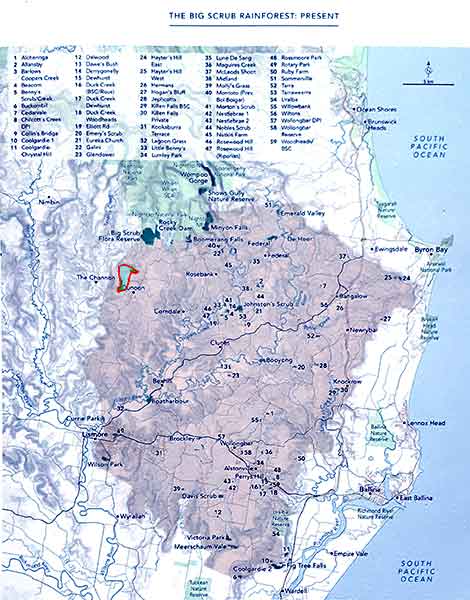
Extent of the Big Scrub Rainforest, with the proposed Dunoon Dam and its EEC imposed. The lowland rainforest at the dam site represents 6.6% of the remaining Big Scrub. From The Big Scrub Rainforest, presented by Rous CC and Big Scrub Landcare, 2017.
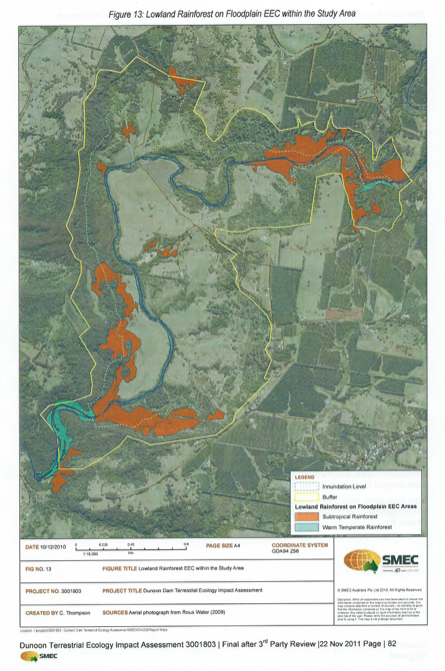
Extract from the TEIA, p.82, showing the extent of the Lowland Rainforest Endangered Ecological Community. Note that the heading is incorrect – this EEC is not “on Floodplain”.
The remaining rainforest would be fragmented and would have greatly increased edge-to-core ratios, rendering it less effective as habitat and more vulnerable to weed invasion.
In addition, the adjoining sclerophyll (eucalypt) vegetation would be reduced, fragmented and damaged, further degrading the available habitat and connectivity.
The 7 ha of warm-temperate rainforest is even more precarious because 6 ha of it would be destroyed. This type is a simpler rainforest, usually with fewer species than subtropical rainforest. It occurs on poorer soils, generally on acid volcanic rocks such as rhyolite in the upper valleys of the Mt Warning caldera, eg in Terania Creek. In The Channon Gorge this type is on sandstone, an occurrence which is almost unknown in the region.
Warm-temperate rainforest usually contains signature species such as Coachwood (Ceratopetalum apetalum). However, in this case other species co-occur in unusual combinations that can’t be fitted into any of the floristic associations that are used by ecologists to help understand rainforest.
For instance, Grey Myrtle (Backhousia myrtifolia), one of the common plants on the site (although not mentioned in the TEIA) is commonly found on poorer soils, but in The Channon Gorge it is growing with typical subtropical rainforest species such as White Beech (Gmelina leichhardtii), which is usually found on richer soils.
This forest can never be recreated. Endangered Ecological Communities are regionally and state significant, not just local, and have a special legal status precisely because they are critically important. The elimination of this EEC would not just be a local loss – it would be an irreparable loss to Australia.
Destroying this EEC should be regarded as wanton vandalism of scientific resources and of our collective heritage.
Loss of threatened flora species
The Northern Rivers area is a known hotspot for plant diversity.
The Mt Warning caldera, on the flanks of which the dam site is located, is recognised nationally and internationally as having highly significant biodiversity. Many of the species in this area occur nowhere else in the world.
According to the TEIA, nine threatened flora species would be affected:
- Arthraxon hispidus Hairy Joint Grass
- Corokia whiteana Corokia
- Desmodium acanthocladum (now Pedleya acanthoclada ) Thorny Pea
- Endiandra muelleri subsp. bracteata Green-leaved Rose Walnut
- Hicksbeachia pinnatifolia Red Bopplenut,
- Macadamia tetraphylla Rough-shelled Bush Nut
- Marsdenia longiloba, Slender Marsdenia
- Ochrosia moorei Southern Ochrosia.
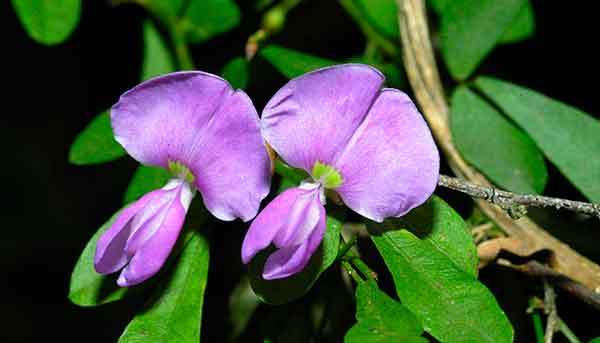
Listed as Threatened in NSW and Vulnerable in Commonwealth legislation, Thorny Pea (Desmodium acanthocladum) is abundant in the forested areas of the proposed inundation zone. Photo: Hugh Nicholson
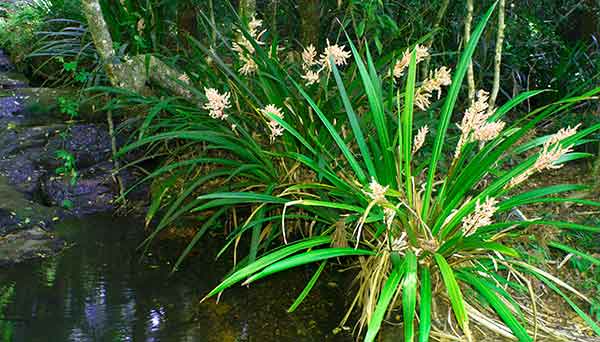
The occurrence of Helmholtzia glaberrima (Stream Lily) in The Channon Gorge is a new southern limit for the species. It appears to be the only Helmholtzia population ever recorded on sandstone. Photo: Hugh Nicholson
This list does not include the Big Scrub Acalypha (Acalypha sp. ‘Big Scrub’), found within the inundation area but not noted by the TEIA. Acalypha eremorum is listed as Endangered in NSW but is in fact Acalypha sp. ‘Big Scrub’. (Rainforest Plants of Australia – Rockhampton to Victoria, an interactive key, Harden, GJ, Nicholson, HRW, McDonald, WJF, Nicholson, NJ & Tame, T, 2014)
Rhodomyrtus psidioides (Native Guava), which is now Critically Endangered due to Myrtle Rust infestations, has been recorded within the inundation zone but was not mentioned in the TEIA.
Loss of flora species is cumulative, relentless and ultimately terminal. When plant representatives of threatened species are destroyed the potential for those plants to re-establish elsewhere is very low.
The successful recruitment of young plants depends on factors which are likely to be disrupted by disturbance, and increased distancing from other fertile adults.
Pollination and fruit dispersal mostly depend on birds, bats or invertebrates, and these are likely to have been eliminated by the loss of other plants on which they depend.
Agreeing to deliberate destruction of these plants and to an increase in the threats against them is a very serious matter with international scientific consequences. It should be rejected outright.
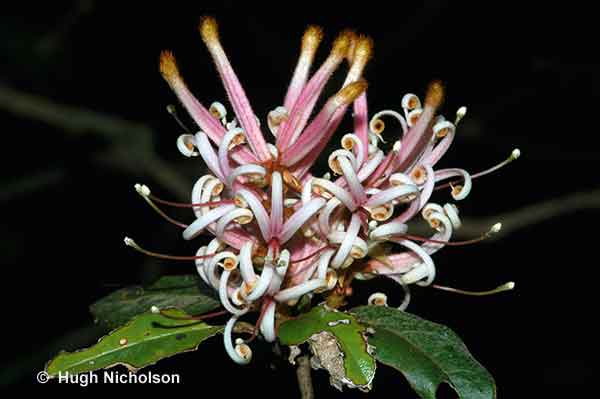
These sweetly-scented flowers belong to Spice Bush, also known as Native Honeysuckle (Triunia youngiana). Its rusty coloured new leaves are ornamental but the red fruits are poisonous. It is found in The Channon Gorge. Photo: Hugh Nicholson
Loss of fauna habitat
It is obvious that these forests and aquatic habitats are home to mammals, birds, reptiles, fish and invertebrates which have nowhere else to go. They cannot move elsewhere because all adjacent niches are already full. They just die.
Local koala habitat will be destroyed by the proposed dam
A new report commissioned by the World Wide Fund for Nature-Australia found the 2019-20 bushfires resulted in the loss of about 71% of koala populations in fire affected areas at six locations on the north coast of New South Wales.
At a time when koalas are predicted to become extinct within a few decades if the current threats continue, no additional threats are acceptable.
This means that the way we have treated koalas in the past has to stop. All habitat loss of koalas must cease if we are to make sure that they do not disappear on our watch.
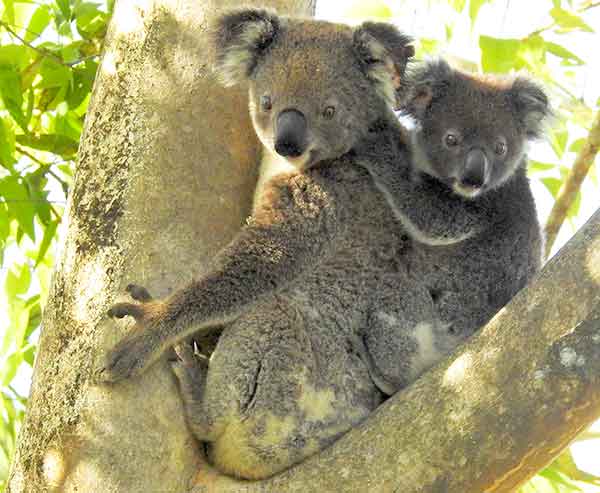
Construction of a new dam and its infrastructure will remove important corridors for the local Koala population. Photo: Hugh Nicholson
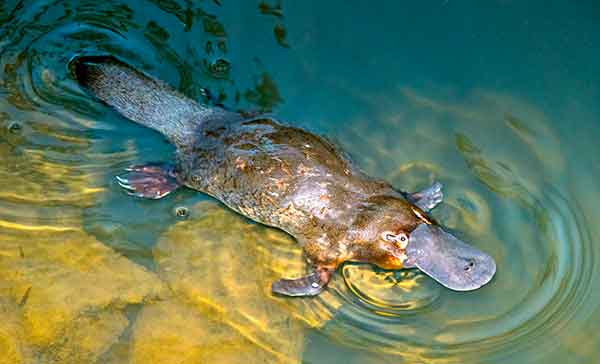
Many Platypus can currently be found in the section of Rocky Creek to be inundated by the dam. These animals would lose their feeding grounds as would those downstream where construction debris would smother the creek bed. Photo: D. Parer & E. Parer-Cook.
Platypus and other aquatic animals adapted to stream habitats do not benefit from a large lake
The 2012 Aquatic Ecology Assessment for the proposed Dunoon Dam states “Mobilisation of sediments via major earthworks would increase the sediment load transported downstream and result in habitat loss through smothering “ (p.61).
The TEIA states, under the heading of Key Threatening Processes: “The dam will alter the natural flow of Rocky Creek both upstream and downstream of the proposed dam wall. The resultant impact is considered (to) be long-term and irreversible” (p.117). For aquatic species irreversible change rarely means a benefit.
For the individuals of fauna species in the destruction zone the loss of their habitat of rainforest and sclerophyll forest is catastrophic. For species as a whole, extinction occurs more slowly, by a 1000 small cuts. The outcome is the same though.
Loss of connectivity
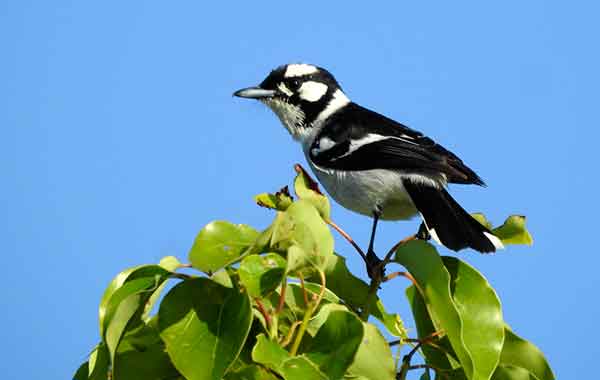
The White-eared Monarch is Vulnerable in NSW where it lives
in the overlap between rainforest and wet sclerophyll forest. It is insectivorous and probably an altitudinal migrant – moving down out of mountain areas during winter. Photo: David Milledge
Severance of local wildlife corridors is a serious problem for animal species that require large territories. The proposed dam site contains a great diversity of habitat types on different soils, slopes and drainages, with markedly different vegetation types.
Many animals do not stay in one type of forest but move between types. Destroying much of this varied forest, fragmenting the rest and installing a deep lake which blocks all terrestrial animals and most of the aquatic ones from essential movement will have an adverse effect on local animal populations.
The territories of larger animals such as koalas will be broken up and their movement corridors disrupted or cut completely. This will affect their survival even if they are not killed outright.
Smaller animals which are lucky enough not to be cleared or drowned will also be threatened by the loss of connectivity. Small isolated populations forced into inbreeding experience genetic decline and ultimately extinction.
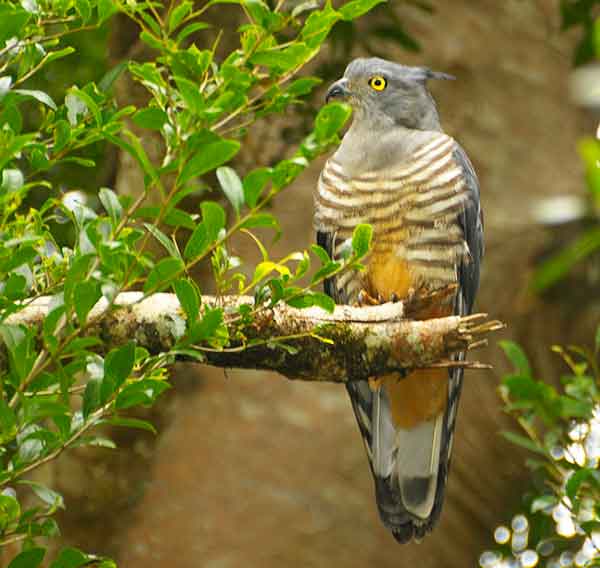
The Crested Hawk (or Pacific Baza as it is now called) is a migratory species which arrives back in our forests in September every year. It is likely they are the same individuals returning to the same area year after year. These forests are to be cleared for construction of the dam wall. Loss of habitat for migratory species is a world-wide problem. We must not add to this burden Photo: Hugh Nicholson
The loss of connectivity, like the loss of species, is cumulative and ultimately disastrous. It should be considered as a major impediment to any destructive proposal such as the dam.
Mitigation
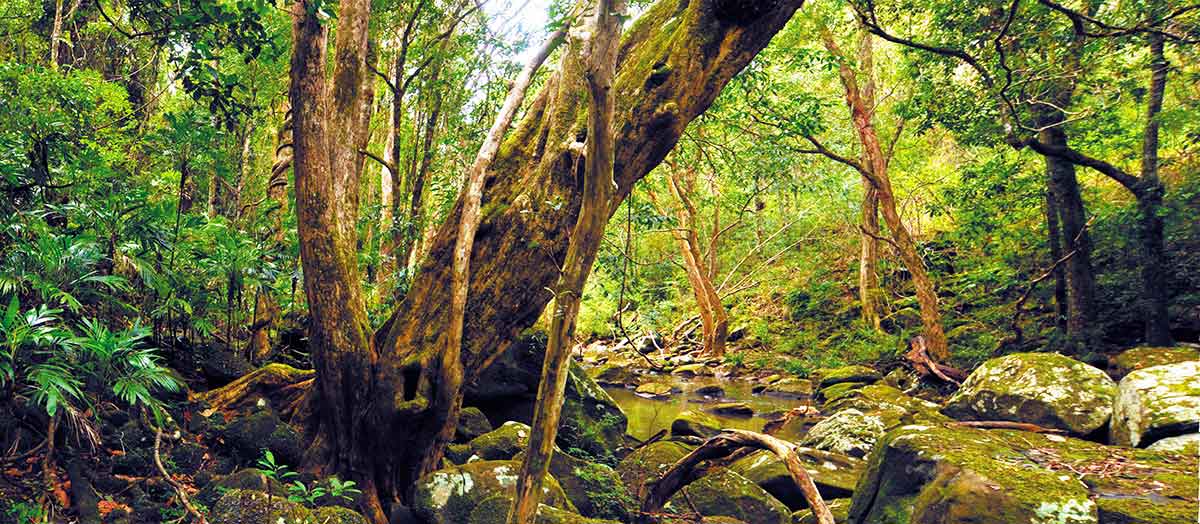
The mitigations proposed in the TEIA are band aid measures which do little to match the magnitude of the proposed destruction. They are full of vague, meaningless, qualifying phrases like “where possible”, “where appropriate”, “should be adopted” “investigate” and “avoid significant areas” (while clearing the most significant areas).
Offsets are proposed, to substitute the unique rainforest on sandstone in the Gorge with regrowing new rainforest on the slopes above the dam – a different and largely degraded forest on different soil types.
Offsets do not work because there is no like-for-like available. And even if they did work, we are at such an advanced state in the downward spiral to extinction of so many species that if an area is identified as similar it should be preserved at all costs in addition to the one proposed for destruction.
One of the more laughable mitigations is that a “qualified fauna ecologist should be within the study area during all clearing work for fauna salvage”! The language betrays the attitude to living animals that will be injured or dead by the time they are “salvaged”.
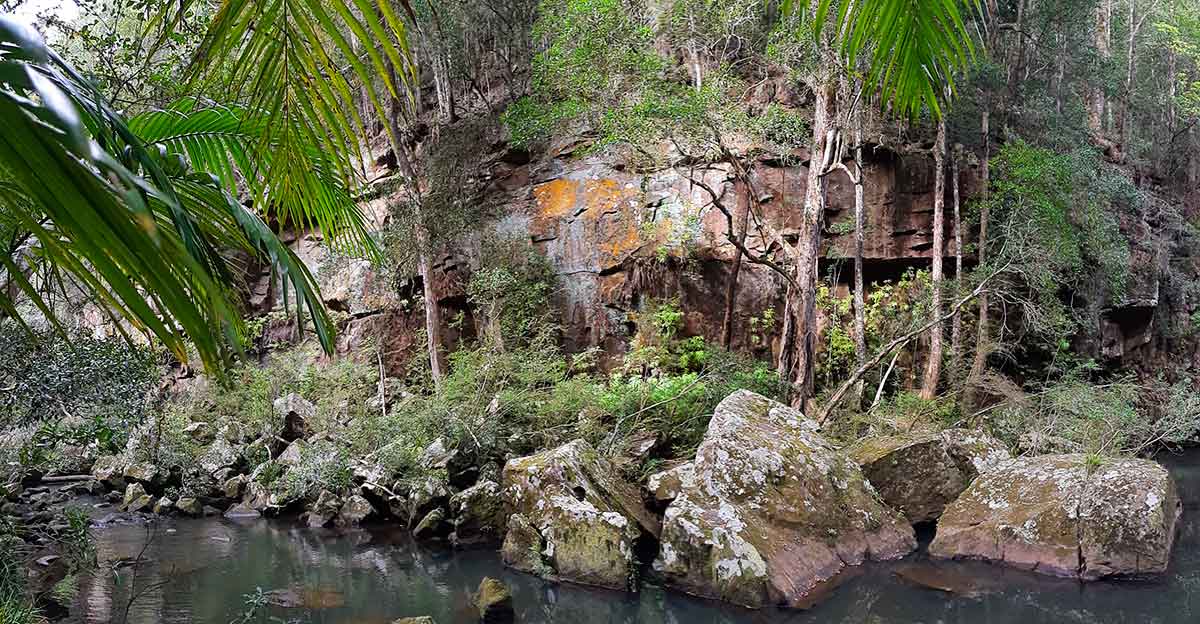
There is no mitigation for something that is priceless. It is something like saying “We are sorry that this project will cause the death of your parents but we plan to mitigate your loss, where possible, and help with offsets or substitutes”.
